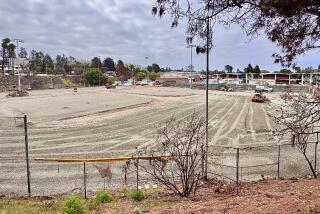Plan to Turn District Headquarters Into High School Resurfaces
- Share via
Disappointed by a less than unanimous recommendation to finish the environmentally troubled Belmont Learning Complex, some Los Angeles school officials Thursday endorsed a proposal to convert their headquarters into a high school instead of completing the building project.
The plan, which only a few weeks ago was shrugged off as impractical, calls for transplanting the Los Angeles Unified School District’s army of bureaucrats to a Mid-Wilshire office tower.
Supporters include Supt. Ruben Zacarias, Los Angeles Board of Education member Julie Korenstein and former Dist. Atty. Ira Reiner, the executive director of the commission charged with weighing the fate of the half-completed high school west of downtown.
On Wednesday, the commission voted 4 to 3 to recommend that the district finish Belmont. On Thursday, commissioners presented arguments for and against the project.
The school board, which appointed the commission two months ago, had hoped for a more resounding consensus. Instead, the split vote and commissioners’ comments afterward contributed to the uncertainty surrounding the project.
Board President Genethia Hayes and most other school board members did not indicate a firm position on Belmont or on alternatives.
The seven-member board is expected to issue a decision Nov. 9 on whether to continue construction, which was partially halted in February pending results of environmental studies.
Reiner, who was not allowed to vote on the matter but who said later that he favors killing Belmont, urged the board to scrap the project.
“I’ve said all along we should consider converting our district headquarters into a school of some kind,” Zacarias said in an interview. “With the lack of available space for schools, such a move makes sense with or without the Belmont issue.”
Korenstein agreed.
“People complain about how it takes years and years to find suitable land,” she said after the meeting. “Well, we own this land. To me this is the fastest solution to building a high school for the children who live in this area.
“But no one is certain that it meets all state requirements,” she said. “We still have to check to find out.”
Reiner said that completing the project would be a “most grievous mistake.”
“This district,” he said, “going through an institutional crisis, cannot afford to expend so much energy, virtually all of its energy, on trying to make right a major disaster at one school when you have responsibility to construct 100 schools in the next 10 years.”
Belmont is being built on an abandoned oil field for which the environmental hazards were not adequately assessed, it was disclosed earlier this year. Opponents argue that it ultimately may be impossible to protect 5,000 students against explosive methane, toxic hydrogen sulfide and other gases at what is already the nation’s most expensive high school.
But supporters--including commission Chairman Cruz Reynoso, a former California Supreme Court justice--contend that the problems can be resolved with the proper technology and that the project is the only way to relieve massively overcrowded schools in the area.
However, he emphasized that work should only proceed if there are legal opinions on issues that could challenge the project, and state-of-the-art antipollution systems backed by funds set aside to operate and maintain them for as long as 75 years.
If those conditions are met--and the project never faces another major obstacle--the Belmont project could be completed in four to five years, Reynoso said.
Given the tainted history of the $200-million project, Reiner estimated that delays could push completion back another decade or more.
But Reiner said key state legislators have indicated that they would be willing to provide up to 80% of the funds needed to refurbish the beige headquarters at what may be the most isolated chunk of property in the city. It is framed by a sheer cliff, Sunset Boulevard, the Hollywood Freeway and the Harbor Freeway.
He figured that the conversion could be completed in two years.
In any case, Reiner warned of worsening relations between the district and state legislators, which could jeopardize state funding for Belmont and other projects. Of particular concern, he said, is the ongoing battle for control of the district between Zacarias and Hayes.
“Right now, this district has a serious problem with the state Legislature that can fairly be described as poisonous,” Reiner said, “and that cannot help but devastate the district as it goes to the state for much-needed funding.”
More to Read
Sign up for Essential California
The most important California stories and recommendations in your inbox every morning.
You may occasionally receive promotional content from the Los Angeles Times.














